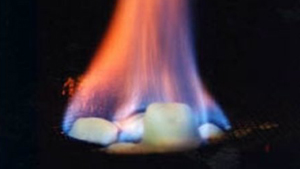|
May 2010 from arstechnica Website
It may look like ice, but it burns.
News reports of the failed attempt to contain the oil-spewing equipment on the bottom of the Gulf of Mexico have referred obliquely to things like "ice crystals" or an "icy slush" clogging the hardware that was intended to cap the leak.
Anyone who is paying attention would recognize that there's a bit of a problem here, in that, even at the temperatures and pressures of the ocean at the site, the water there is very much in its liquid phase, as are the hydrocarbons that are spewing through the leak. The methane that caused the original explosion remains gaseous down to -161°C.
The
"ice" that's forming is actually a solidified mixture of methane and
water called a clathrate. Clathrates have also been in the news
because of a potential role in climate change, so it seems like an
opportune time to explain what they are.
This isn't especially favorable on the atomic scale,
since water molecules don't normally settle down and form stable
connections with partners when it's in the liquid form. But, by
locking the nonpolar substance in place, they limit its contact with
the rest of the liquid, which ends up being favorable overall.
It's easy for the hydrogen bonding network of water that surrounds it to fold back on itself and form a complete cage that traps some methane inside of it. This locks a collection of water molecules into a stable structure that looks a lot like the one present in ice. Since the water is already locked in place as part of a cage, it's actually better (from an energetic standpoint) to form additional cages by growing them off the side of an existing one.
As more and
more cages get added on, the end result is an ice-like solid that
stores a significant amount of methane.
The simplest to understand is the option of placing a heating element inside the box, which would raise the temperatures above the point where clathrates are stable. An alternative is to pump a partly polar molecule, like ethanol or methanol, into the site. Because these can interact with both water and methane, they keep the stable cage structures from forming.
Both of those aren't long-term solutions, since they require constant attention, but they could serve as stop-gaps until a permanent fix is put into place.
Bacteria
in ocean sediments produce methane all the time, and a lot of that
ends up trapped in deep ocean clathrates. Many estimates of their
volume indicate that there's more methane in clathrate form than we
can possibly ever hope to extract through traditional drilling. It's
not an obvious source of energy, however, given that nobody has
figured out how to recover significant quantities of it.
As the atmosphere continues to warm, some of that heat inevitably gets transferred to the oceans, which will slowly heat up as well. Since clathrates are very sensitive to temperature, there's a chance that some of them will reach a point where they're unstable at the prevailing temperatures, and they'll melt, releasing methane into the atmosphere.
This is especially true in polar regions, where low
temperatures have allowed clathrates to form at relatively low
pressures.
|

